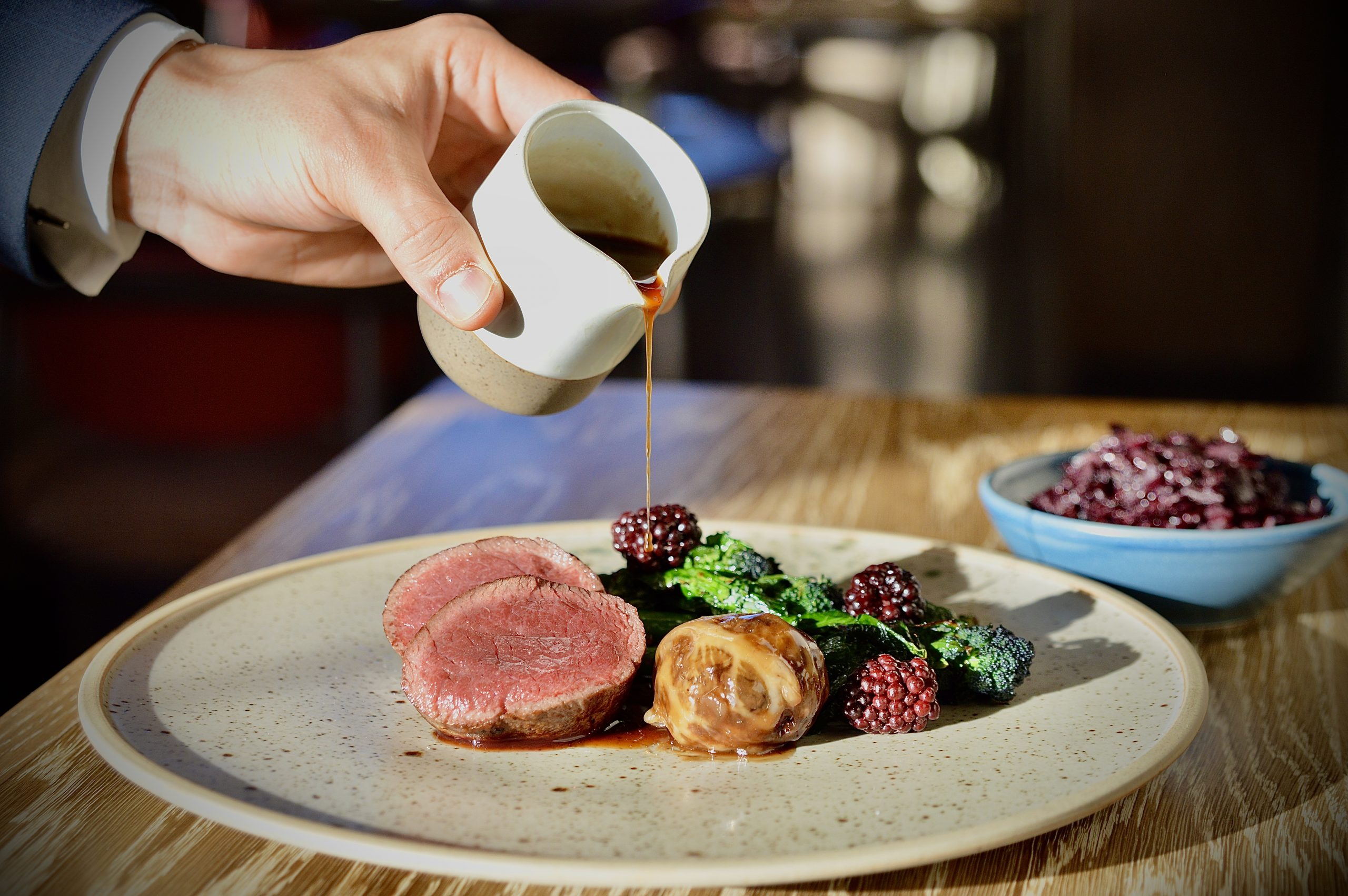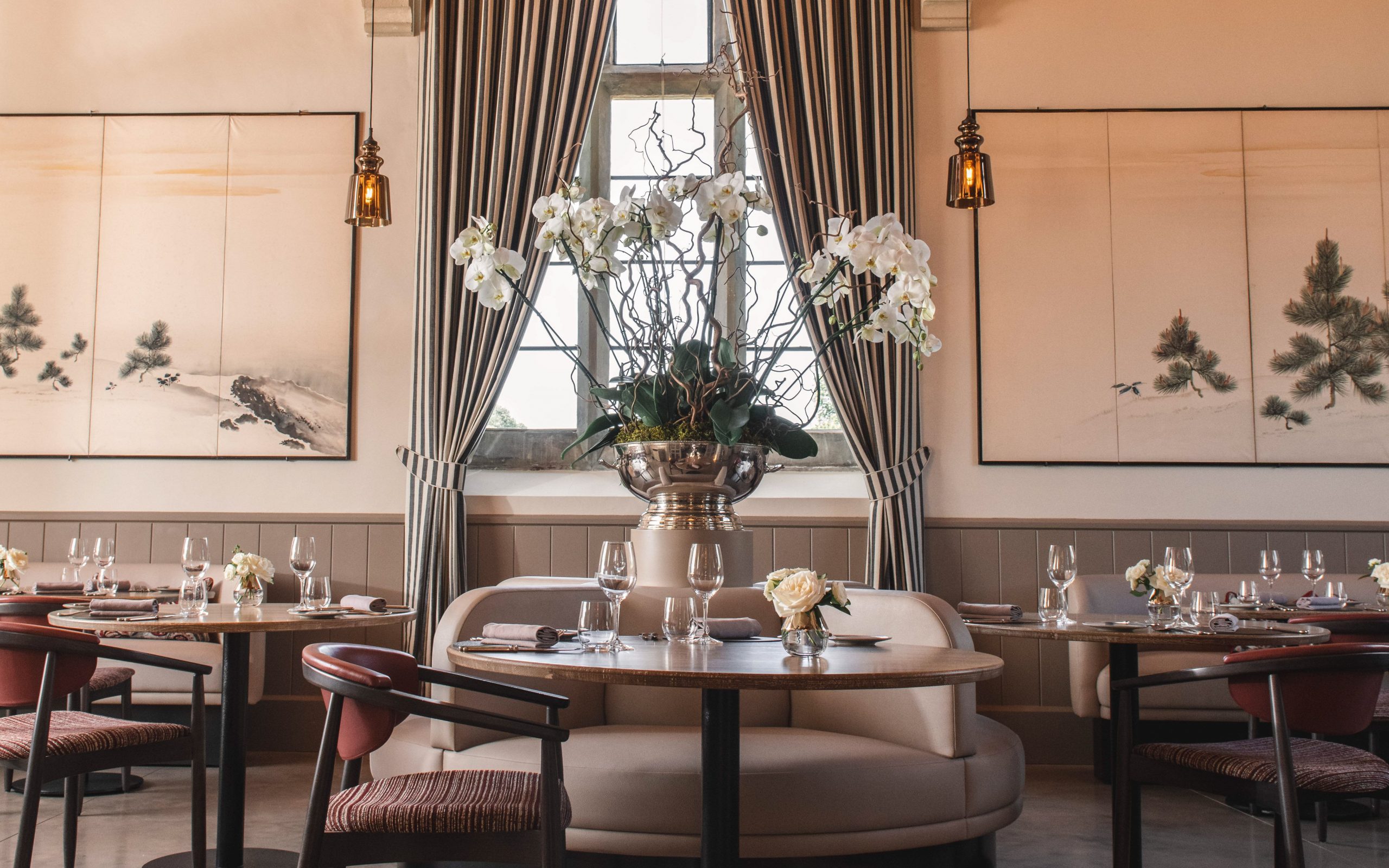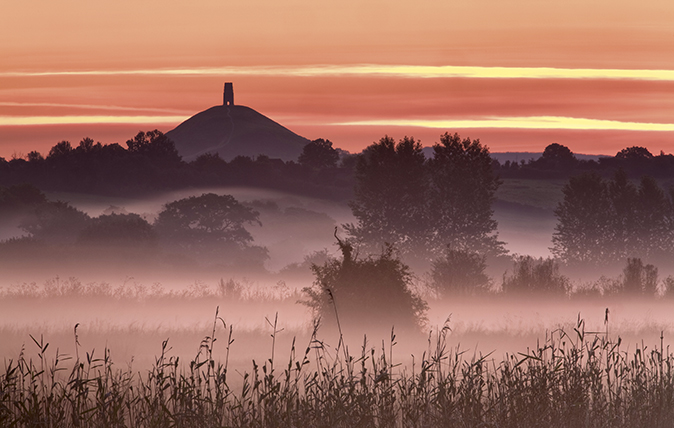The Clockspire restaurant review: A sensation in Somerset — and how to prepare their signature venison dish
The Clockspire in sleepy Milborne Port offers a stylish slice of sophisticated dining that you might not expect to discover in rural Somerset. Paula Lester paid a visit, and came away with an amazing experience — and a wonderful venison recipe to share.


From the moment you enter The Clockspire — stepping under the carefully-restored stone arches to the huge double door of this establishment ensconced in a 19th century former school house — you know it’s going to be a memorable experience.
Inside, it’s all light, bright and modern, with polished concrete floors, a pale colour palette and a tasteful, yet statuesque, flower arrangement as the focal point of the main dining room. Indeed, the refurbishment — which was masterminded by co-owner Mike Fisher’s London architectural and design firm, Studio Indigo — is so successful that the only giveaways that this fine building was once the village school are the soaring wood-panelled ceilings and the enormous, full-height mullion windows.
Of course, a flourishing restaurant needs far more than a swanky interior to do well, but, fortunately, this one — which opened in 2019 — also benefits from a gifted head chef and an efficient, albeit unfussy and definitely not snooty, front-of-house team. Having dined here a lot — it’s our go-to place for special occasions, as it’s pricey, but a real treat — it’s the commitment of those who work here that make it so exceptional.
On arrival, diners are escorted up the stairs to the mezzanine-level bar, where it’s possible to indulge in any cocktail or aperitif of your choice, accompanied by tasty nibbles, while perusing the various menus. The last time we visited, we went for the tasting menu — which must be ordered by the entire table and costs £75 per head, with an extra £55 for the wine pairing — even though my husband, Simon, was hesitant about the raw beef with celeriac, rye cracker and burnt onion.
Once seated at the head of what would have been the main teaching room, we embarked on a culinary journey without so much of a whiff of those disappointing school dinners. After a selection of ‘snacks’, served with a spoiling glass of Champagne, we moved onto a delicious umami mushroom soup, with sheep’s curd and pickled grape, along with the most delicate Domaine Baudouin Millet Chablis.
Next up, an exquisitely-presented dish of cured salmon, hazelnut, meadowsweet and blackcurrant, washed down with a typically floral Albariño. Then, the controversial raw beef, accompanied by a velvety-soft Argentinian Petit Verdot from Bodega Ruca Malen. Such is the skill of Mr Sutton and his five-strong brigade, my husband declared the dish as the best on the menu. But, for me, the stand out plate was the ensuing, melt-in-the-mouth venison loin, king oyster mushroom, turnip and elderberry, with a Californian Cypress Vineyards Zinfandel.
Then, if that was not enough, we were treated to not only one, but two puddings: a white lake solstice, with truffle honey and apple — served with an Italian Fratelli Muratori Gardini Arimie — and caramelised white chocolate, blackcurrant and peach leaf ice cream, brought to life by a glass of Château Septy from Monbazillac.
Exquisite houses, the beauty of Nature, and how to get the most from your life, straight to your inbox.

Every time we’ve eaten at The Clockspire, I’ve offered a silent prayer of thanks that its owners (Mike Fisher and his partner, Lord Allen — who have a home in Milborne Port — and experienced restaurateur, Alistair Storey) decided to breath life back into this old building and invest in such a smart restaurant. That they gathered such a great team — recruiting both Mr Sutton and Restaurant Manager, Thomas Gamella, from Mr Storey’s one Michelin star The Woodspeen in Berkshire, along with the genial General Manager, Massimiliano Mannella, from Gordon Ramsay’s London House — was a master stroke, too. It’s clear that the team prides itself on being welcoming and professional, reflected in the fact that Mr Gammella is a recent recipient of an award of excellence from the Royal Academy of Culinary Arts.
Although the Covid 19 pandemic and Brexit-induced staff recruitment issues have tested the team in the two years since The Clockspire opened, they’ve not stood still. During the lockdowns, they launched luxurious cook-at-home ‘chef boxes’ and, in conjunction with The Somerset Spirit Company in Castle Cary, created a 12 O’Clock gin. Most recently, they’ve devised a Christmas hamper, featuring goodies such as their own handmade chocolate truffles, a Christmas pudding, macarons, chutney and the aforementioned gin, as well as charcuterie and cheeses from local suppliers.
Not forgetting, of course, continuing to push the food boundaries with a tantalising à la carte menu — I like the sound of partridge breast with crispy leg, black pudding, cider cabbage and sourdough bread sauce — and £30 a head festive lunch menu.
‘What we offer is very natural and inspired by our surroundings,’ enthuses Mr Mannella, who lauds Mr Sutton as ‘a master forager’ with a gift for mixing things up and creating new dishes. ‘I’d change the menu every day, if these guys would let me,’ admits Mr Sutton. ‘We specialise in modern, British food — good ingredients cooked properly, with a bit of fun.’
The Clockspire, Gainsborough, Milborne Port, Sherborne DT9 5BA — www.theclockspire.com
Recipe: The Clockspire’s roasted venison loin, faggot, slow cooked red cabbage, purple sprouting broccoli and blackberry
‘Autumn and winter have always been my favourite time of year', writes Luke Sutton, Head Chef at The Clockspire. 'The crisp, frosty mornings, the beautiful variety of colours from the leaves falling off the trees and, as a cook, the amazing larder of ingredients and produce around — the late summer harvests meeting early winter crops, which leave us with so much to choose from. As the nights draw in, we find comfort in earthy flavours and a little spice here and there.'This dish showcases some great seasonal ingredients that we look forward to cooking each year. The red cabbage — bursting with acidity from the fruit juice — is a great festive side dish and the faggots can be a tasty midweek supper, when accompanied with some proper mash and greens. Venison is a truly sustainable and versatile protein choice, abundant and still so underused in our home cooking.'This dish can be prepared completely in advance, the venison can sit in the low temperature oven for a good hour or so without over cooking, just cook the broccoli when you need it.’
Ingredients (serves 4)
- 500g venison loin, trimmed of any sinew
For the venison faggots
- 250g venison mince
- 250g pork belly mince
- 100g minced lardo (optional, but will result in a softer end result)
- 150g chicken livers, diced
- 75g prunes, diced
- 1 medium size white onion, finely chopped
- 25g butter
- 50g breadcrumbs (we use our sourdough)
- 40g streaky bacon, diced
- 1 clove of garlic
- 10g of salt
- 1g black pepper
- 1g mace or nutmeg
- Caul fat to wrap (optional, but should be available from your local butcher
To cook the faggots:
- 50g butter
- 500ml beef stock
- Sprig of thyme
For the red cabbage and broccoli:
- 500g purple sprouting broccoli
- 4 red onions, finely sliced
- 1 medium sized red cabbage, finely shredded
- 50ml red wine vinegar
- 1 cinnamon stick
- 5 juniper berries
- 1 bottle of red wine
- 200ml fresh fruit juice, such as blackcurrant or cranberry
- 30g redcurrant jelly
- 30g soft brown sugar
- 50g duck fat
- Salt and pepper
Method
Start by making the faggots. Sweat the onions and garlic with the salt in the butter until soft (about 5 minutes over a low heat), before adding the nutmeg and pepper and allowing to cool. Then, mix all the ingredients together until evenly blended and mould balls that weigh about 50g each (going larger or smaller if you prefer).
Chill them down for 30 minutes in the fridge so the mix can firm up, then lay the caul fat out on a board and place the balls on top with enough space between each one. Cut the caul fat between the faggots and wrap carefully around each ball, with a little overlap. They can be frozen at this stage, if you wish.
To cook the faggots, heat the butter in a pan until it begins to foam. Add the faggots and thyme and cook over a medium heat until beginning to colour the faggots. Add the stock and simmer for 10-15 minutes until the faggots feel firm to the touch.
To make the red cabbage, slowly caramelise the red onions in the duck fat, over a medium/low heat until golden and soft. Add the wine and allow to come to the boil before turning down to a simmer. Add the juice, redcurrant jelly, sugar and vinegar and cook for a further 10 minutes. Wrap the cinnamon and juniper berries in a small muslin wrap and add to the pan along with the cabbage, stir to mix well and cook until the cabbage is tender and the liquid is reduced to a glaze-like consistency and coats the cabbage.
For the purple sprouting broccoli, simply bring a pan of well salted water to a boil, blanch the broccoli for 2 minutes, then drain onto a tray lined with kitchen roll.
To cook the venison loin, heat your oven to 60˚C, oil the venison loin, place it on a tray in the oven and leave for 45 minutes. Remove the venison from the oven and place into a hot pan with a little oil, turning the meat every 30 seconds or so until evenly coloured. Remove from the heat and allow to rest for at least 5 minutes, then carve into even slices ready to serve.
To serve, reheat the cabbage until warmed through and put it into a suitable dish for the table. Arrange the broccoli, carved venison loin and a faggot on each plate, being sure to pour the leftover sauce from the faggot pan to finish the dish, before adding two or three blackberries to each plate and serving.

12 fascinating facts about Somerset, from to King Arthur’s Avalon to the skeleton at the bottom of Cheddar Gorge
From the watery Levels and mystical Glastonbury Tor to the wild, heathery hills of Exmoor, Somerset is a vast, mainly

Credit: Getty Images/Alloy
In Focus: Fingerposts, the quirky and beautiful signposts which dot the British countryside
Even if no one agrees what a red fingerpost denotes, rural communities still cherish their historic signage, says Richard Webber.
An experienced journalist, Paula Minchin, Country Life's Managing & Features Editor, has worked for the magazine for 10 years — during which time she’s overseen two special issues guest-edited by His Majesty The King in 2013 and in 2018, and the bestselling 2022 edition masterminded by his wife, Queen Camilla. A gamekeeper’s daughter, Paula began her career as a crime reporter on The Sidmouth Herald in Devon, before becoming Pony Club & Young Rider Editor, then Racing Editor, at Horse & Hound. Paula lives in Somerset with her two working Labradors, Nimrod and Rocky.
